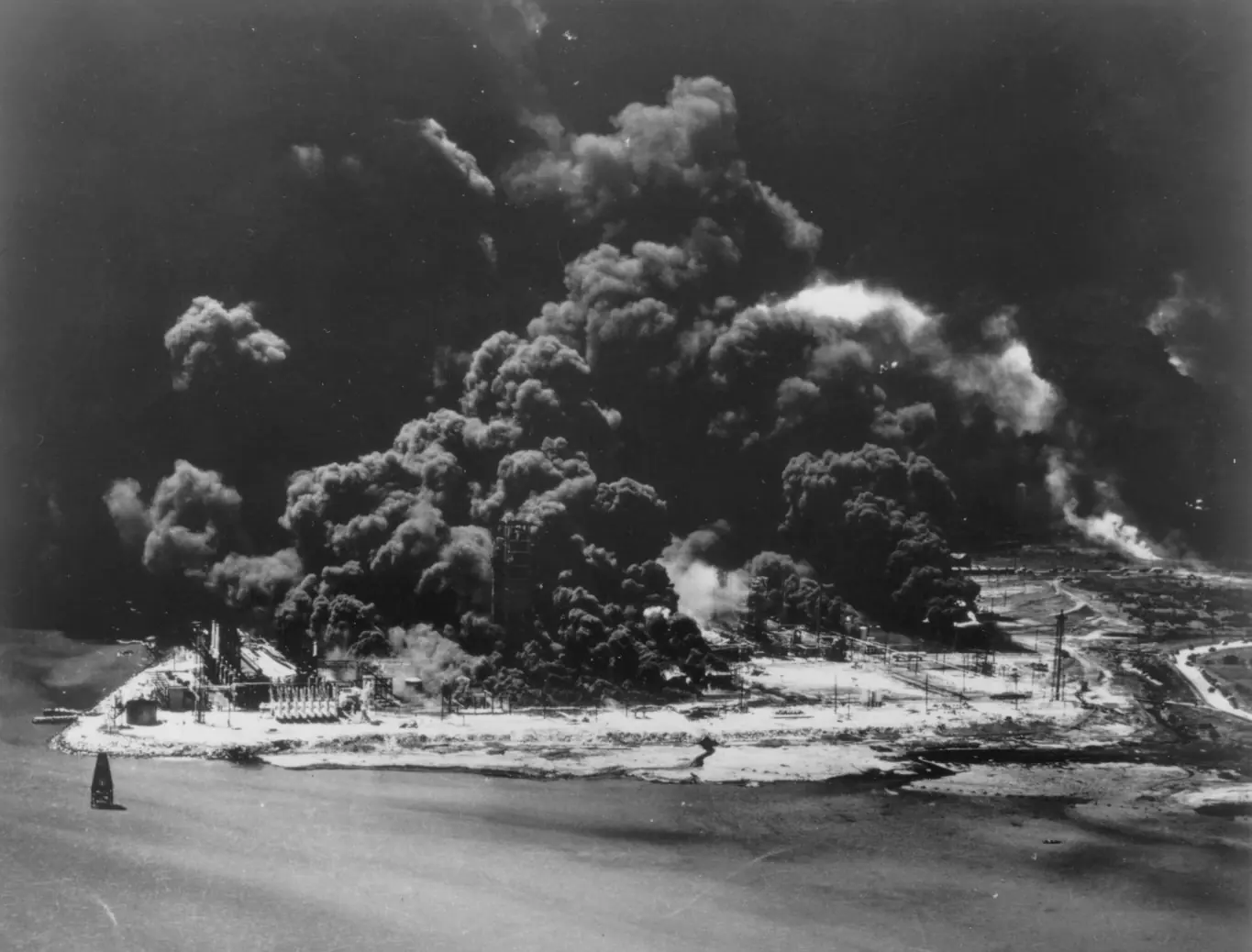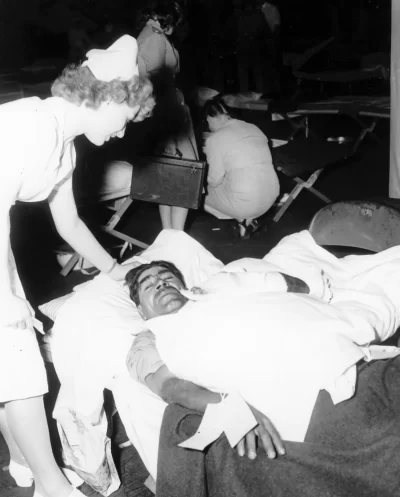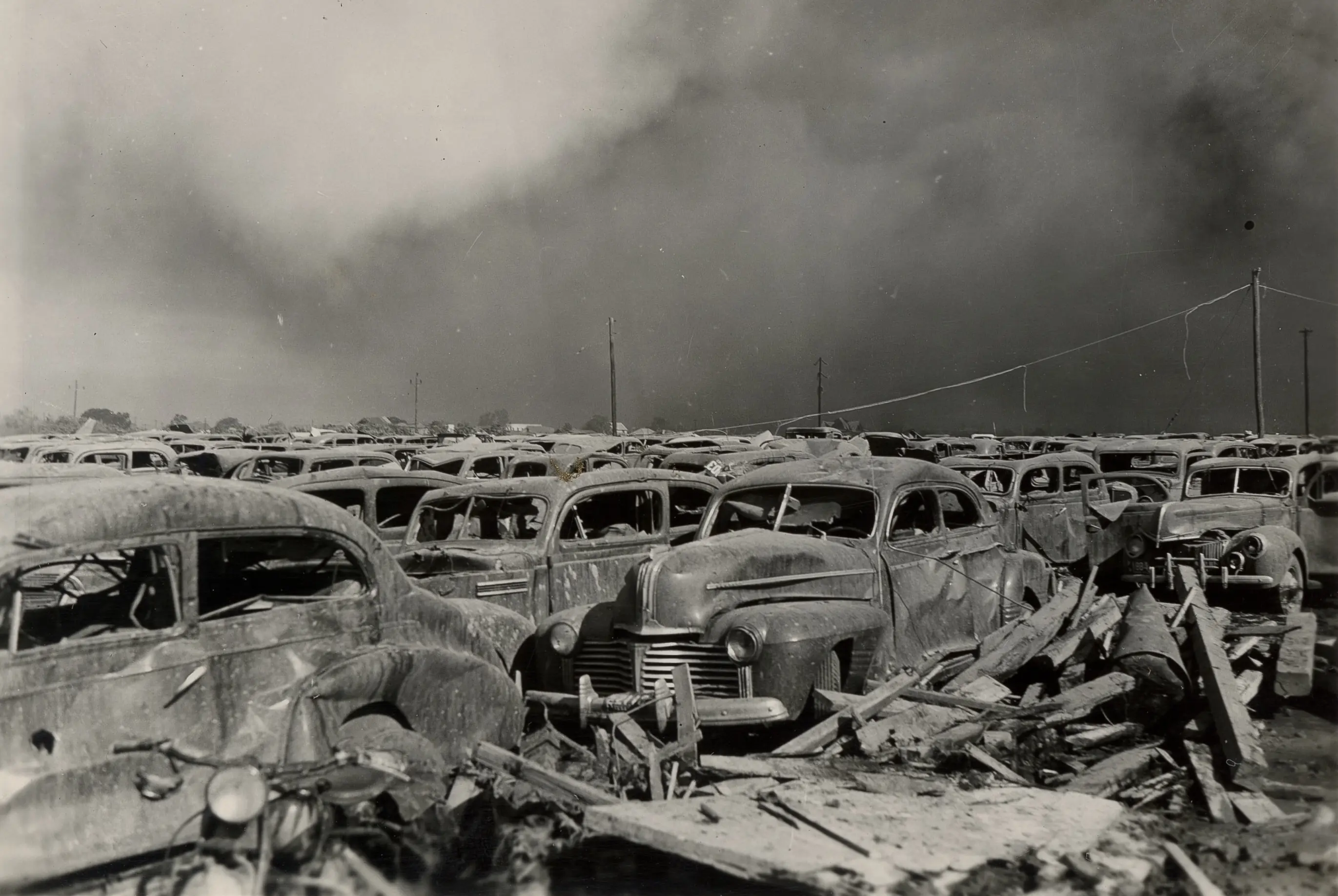On the morning of April 16, 1947, the port city of Texas City, situated on Galveston Bay, became the scene of one of the deadliest industrial accidents in American history. Shortly after dawn, longshoremen were loading ammonium nitrate fertilizer onto the French cargo vessel Grandcamp, a Liberty ship repurposed for commercial use. The fertilizer — a dense, highly oxidizing compound originally produced during World War II for munitions and later recycled as agricultural feedstock — was destined for European farms but was stored and shipped in bulk under conditions poorly understood by those handling it.
The Blast
At approximately 8:00 a.m., stevedores noticed smoke rising from the ship’s hold. Believing that moisture and steam might control the smoldering fertilizer, the crew sealed the hatches and injected steam, an action intended to extinguish the fire but that likely increased heat and pressure. At 9:12 a.m., the cargo detonated with a force so great it was felt more than a hundred miles away.

The explosion instantly destroyed the Grandcamp and ripped through the port. Dockside warehouses, the Monsanto Chemical Company complex, grain elevators, and nearby refineries and chemical plants collapsed or caught fire. A 15-foot tidal wave swept into the bay. Windows shattered in Galveston and Houston; a seismograph in Denver registered the shock.
The blast killed twenty-six members of the city’s volunteer fire department and destroyed all of Texas City’s firefighting equipment, including four trucks, leaving the community unable to mount an organized fire response. The High Flyer, a second ship nearby and also carrying ammonium nitrate, caught fire and was towed about 100 feet from the docks in an attempt to reduce danger. It exploded at 1:10 a.m. on April 17 — about sixteen hours after the first blast — compounding the devastation and hindering ongoing rescue work.

Destruction and Casualties
Texas City’s industrial district was leveled. Oil refineries and chemical facilities that anchored the local economy burned for days. Hundreds of homes and small businesses were flattened or left uninhabitable. Power and water service were cut off across much of the city. The official death toll is uncertain, but the anchor monument in the memorial cemetery records 576 known dead: 398 identified, 178 missing. Many of the dead were longshoremen, firefighters, ship crews, and spectators who had gathered to watch the initial fire. Some victims were vaporized or left unrecognizable, and sixty-three bodies were buried without identification. Contemporary counts placed the injured in the thousands, with estimates exceeding 5,000. Tens of thousands were displaced.

Emergency response was improvised and chaotic. With local fire protection destroyed and no centralized disaster plan in place, medical personnel were overwhelmed. Volunteers from surrounding towns converged to fight fires and search rubble, and the Red Cross and U.S. military dispatched personnel and supplies. Temporary hospitals, morgues, and shelters were set up as railroads offered free evacuation trains for survivors.
Economic Consequences
Texas City in 1947 was built around its port and petrochemical plants. The destruction shut down major employers and disrupted oil refining, synthetic rubber production, and shipping along the Gulf Coast. Insured property losses were estimated at about $67 million in 1947 dollars — an enormous sum for a small city.
Many families lost both wage earners and homes. Local commerce took years to recover, and the city government faced a depleted tax base at the very moment it needed funds to rebuild. Temporary housing was donated and used through the late 1940s, and docks, warehouses, and plants were largely rebuilt by 1950.

Legal Fallout and the Federal Tort Claims Act
The scale of harm raised unprecedented questions about responsibility. The ammonium nitrate had been manufactured by U.S. government ordnance plants and distributed for postwar export. Victims and survivors filed more than 3,000 lawsuits against the federal government under the new Federal Tort Claims Act of 1946, which for the first time allowed negligence claims against the United States. The lead case, Dalehite v. United States (1953), reached the Supreme Court. Plaintiffs argued that federal agencies failed to warn about the fertilizer’s instability and permitted unsafe shipping practices. The Court ruled 4–3 that the government was protected by the “discretionary function” exception, barring liability for high-level policy choices.
Although that decision blocked most recovery, Congress responded with a special settlement act in 1956 that distributed about $16.5 million to victims and families. Separate suits against the Republic of France, owner of the Grandcamp, were ultimately rejected; in 1962 the Supreme Court declined to review a ruling that France could not be held liable in U.S. courts.
Regulatory Lessons
While no single sweeping federal law followed immediately, the disaster reshaped industrial safety thinking:
- Maritime and Port Safety: Shipping codes for hazardous cargo tightened, with clearer labeling, ventilation requirements, and temperature monitoring for oxidizing chemicals. Ports improved fire-prevention planning and evacuation procedures.
- Chemical Manufacturing Oversight: Fertilizer production standards evolved to reduce explosive potential through additives and better packaging. Plants began more systematic hazard analysis and emergency training.
- Workplace and Fire Safety: The catastrophe strengthened support for occupational safety standards in chemical and refining industries, helping set the stage for later nationwide frameworks.
- Disaster Planning: Texas City’s experience underscored the need for coordinated municipal emergency management and mutual-aid agreements between cities and industrial facilities.
These reforms came gradually, but the memory of 1947 became a reference point whenever hazardous-materials regulations and public-safety investments were debated.

Civic Memory and Legacy
Public remembrance began quickly. In June 1947, the bodies of unidentified victims were buried together in a memorial cemetery and park; a new section was added in 1991. Annual commemorations honor the firefighters, longshoremen, and residents who died. For safety professionals and historians, the explosions remain a case study in how overlooked chemical hazards can cascade into urban catastrophe.
The Texas City Disaster of 1947 stands as both a human calamity and a turning point in American thinking about industrial hazards. It spurred improvements in shipping and chemical safety, pushed courts and Congress to grapple with government accountability, and forced communities and industries to plan for emergencies once considered unimaginable.



